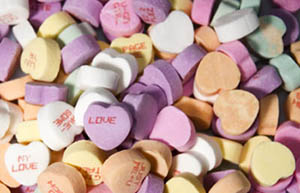- Details
- Category: Valentines Day Valentines Day
- Hits: 5437 5437
 In Shakespeare's Hamlet, Queen Gertrude offers the now-loved sentiment “Sweets to the Sweet. Perhaps this is the origin of the tradition of giving candy to a loved one. Early American colonists made homemade candies with love notes scratched on the surface for Valentine's Day. New England Confectionary Company (NECCO) expanded upon the colonists idea and created the conversation heart in the mid-1800s.
In Shakespeare's Hamlet, Queen Gertrude offers the now-loved sentiment “Sweets to the Sweet. Perhaps this is the origin of the tradition of giving candy to a loved one. Early American colonists made homemade candies with love notes scratched on the surface for Valentine's Day. New England Confectionary Company (NECCO) expanded upon the colonists idea and created the conversation heart in the mid-1800s.
In 1860, Daniel Chase, brother of NECCO founder Oliver Chase, invented the process to print motto candies. Originally, the candies were cockles small, crisp, scallop shell-shaped candy wrapped in colored paper with printed sayings. The Sweet Hearts, the name used for candies with mottos inscribed directly on them, were invented in 1900. The candy was cut into shapes like horseshoes and baseballs. This allowed for longer sayings to be printed on them such as “How long shall I have to wait? Pray be considerate. This enabled would-be-lovers to send messages to each other.
As time went on, the sayings became shorter and more to the point. The familiar heart shape was also produced. Original sayings include be mine, kiss me and my man. Every year new sayings are added.
Today, conversation hearts are one of the most popular Valentine’s Day candies. People all over the country love to give them to their valentines and they are especially popular with school children.
How they are made:It takes a combination of machines and skilled candy makers to produce conversation hearts. Many of the machines used to make conversation hearts are the original machines or exact replicas. History is still at work in the manufacturing process of conversation hearts.
First sugar, color and other ingredients are mixed together. When the mix feels like dough, it is ready to be made into hearts. Workers pick up the dough and take it to a machine that flattens it. Another machine stamps a saying like ‘cutie pie’ on it. The same machine also will cut the dough into hearts. The candy drops on a conveyor belt that takes the conversation hearts to a dryer. Once the candy is dry, it gets mixed in with other colors. Finally, the hearts are boxed and shipped.
